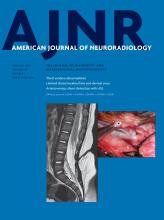Research ArticleAdult Brain
Collateral Assessment by CT Angiography as a Predictor of Outcome in Symptomatic Cervical Internal Carotid Artery Occlusion
S. Sundaram, S. Kannoth, B. Thomas, P.S. Sarma and P.N. Sylaja
American Journal of Neuroradiology January 2017, 38 (1) 52-57; DOI: https://doi.org/10.3174/ajnr.A4957
S. Sundaram
aFrom the Department of Neurology (S.S., P.N.S.), Comprehensive Stroke Care Program
S. Kannoth
bDepartment of Imaging Sciences and Interventional Radiology (S.K., B.T.)
B. Thomas
bDepartment of Imaging Sciences and Interventional Radiology (S.K., B.T.)
P.S. Sarma
cAchutha Menon Centre for Health Science Studies (P.S.S.), Sree Chitra Tirunal Institute for Medical Sciences and Technology, Trivandrum, India.
P.N. Sylaja
aFrom the Department of Neurology (S.S., P.N.S.), Comprehensive Stroke Care Program

References
- 1.↵
- Powers WJ
- 2.↵
- Liebeskind DS
- 3.↵
- Miteff F,
- Levi CR,
- Bateman GA, et al
- 4.↵
- 5.↵
- Liebeskind DS,
- Jahan R,
- Nogueira RG, et al
- 6.↵
- Vernieri F,
- Pasqualetti P,
- Matteis M, et al
- 7.↵
- Lima FO,
- Furie KL,
- Silva GS, et al
- 8.↵
- Bang OY,
- Lee PH,
- Heo KG, et al
- 9.↵
- Maas MB,
- Lev MH,
- Ay H, et al
- 10.↵
- Hofmeijer J,
- Klijn CJ,
- Kappelle LJ, et al
- 11.↵
- 12.↵
- Orge F,
- Harris A,
- Kagemann L, et al
- 13.↵
- 14.↵
- 15.↵
- Bang OY,
- Saver JL,
- Kim SJ, et al
- 16.↵
- Bang OY,
- Saver JL,
- Buck BH, et al
- 17.↵
- McVerry F,
- Liebeskind DS,
- Muir KW
- 18.↵
- Liebeskind DS
- 19.↵
- Silvestrini M,
- Altamura C,
- Cerqua R, et al
- 20.↵
- 21.↵
- Hartkamp MJ,
- van Der Grond J,
- van Everdingen KJ, et al
- 22.↵
- Shuaib A,
- Butcher K,
- Mohammad AA, et al
- 23.↵
- Riggs HE,
- Rupps C
- 24.↵
- Widder B,
- Kleiser B,
- Krapf H
- 25.↵
- Derdeyn CP,
- Videen TO,
- Fritsch SM, et al
- 26.↵
- Liebeskind DS,
- Sansing LH
In this issue
American Journal of Neuroradiology
Vol. 38, Issue 1
1 Jan 2017
Advertisement
S. Sundaram, S. Kannoth, B. Thomas, P.S. Sarma, P.N. Sylaja
Collateral Assessment by CT Angiography as a Predictor of Outcome in Symptomatic Cervical Internal Carotid Artery Occlusion
American Journal of Neuroradiology Jan 2017, 38 (1) 52-57; DOI: 10.3174/ajnr.A4957
0 Responses
Jump to section
Related Articles
Cited By...
This article has not yet been cited by articles in journals that are participating in Crossref Cited-by Linking.
More in this TOC Section
Similar Articles
Advertisement











